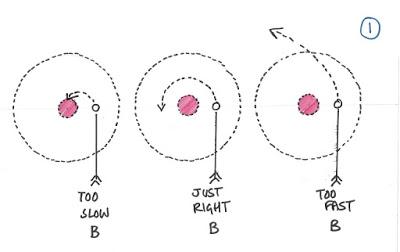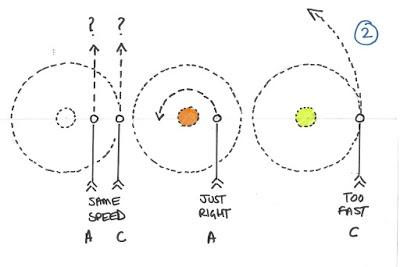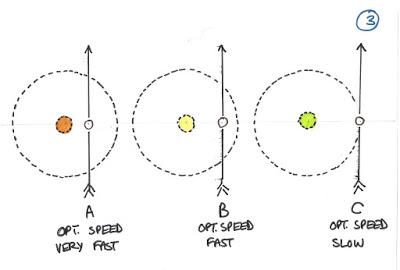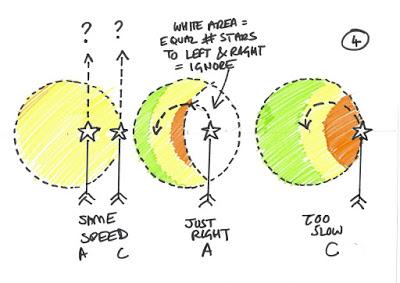And lo, the second and final part in my mini-series on why the planets revolving a sun follow Newton's rules/General Relativity (the larger the orbit, the slower the planet) but stars revolving a galaxy do not. Beyond a certain radius, their speeds remain constant, so they can maintain the spiral arm shape.
This is a slightly different explanation to Part 1, the conclusion of which might well be completely wrong (theses are just thought experiments, because I like thinking about stuff), but if it's correct, then the two explanations complement each other.
In words: taking gravity as a given, the orbit of a planet around the sun (or of a star round a galaxy) does not determine its final speed; it is its initial arrival speed which determines its orbit. If its arrival speed is not right for its initial orbit, it will either spiral in to the center or fly straight on and end up in another solar system (or galaxy).
So you have to skip back to how solar systems or galaxies were formed in the first place, and there's your answer, no Dark Matter required. (The fact that nobody really knows what gravity really 'is' or how gravity actually 'works' is irrelevant if we are only thinking about its effects. I don't know how computers or the Internet work, but I can still use them.)
There was basically loads of stuff whizzing round, it formed the only patterns it could possibly have formed. If you just look at finished solar systems or galaxies, you ignore all the stuff that passed a system or galaxy with which its direction and speed were not compatible and so ended up in another system or galaxy, or floating through space on its own; for a bit of a stuff to end up particular system or galaxy is the exception not the rule.
A solar system or a galaxy is the result of a series of happy coincidences. It's like evolution. To invoke Dark Matter is like invoking Intelligent Design.
With pictures:
1. A simple solar system.
Planets are formed from dust and rocks which were spewed out by dying stars and whizz through space until they are caught by the gravity of a sun. They don't arrive fully formed, but to be caught, their constituent rocks have to be traveling at the right speed and distance from the sun.
For a given distance from the sun, if Rock B is traveling too slow, it will fall into the sun, if too fast, it will change path slightly but then whizz off into space again. Its speed has to be 'just right' for it to end up in a fairly stable orbit. It then merges with other rocks traveling on a similar orbit at a similar speed form a planet. Cruithne is traveling round the Sun on a similar orbit to Earth at a similar speed, but is more or less opposite Earth so the two won't collide and merge any time soon.
Rocks and planets have no memory, when a planet reaches the place illustrated with a small white circle, traveling perpendicular to the sun (pink), all they 'know' is that they want to continue traveling in the direction of the solid arrow. It doesn't matter whether they just arrived fully formed along the solid arrow or were already in that orbit at that speed.

2. The right speed is different, depending on what their (initial) trajectory is
Imagine rock A and rock C, which happen to pass into the sun's gravity (the dotted circle), traveling at the same speed, and let's imagine that this is the optimum speed for rock A. Rock A feels a strong gravitational force as it passes quite close to the sun. So I have coloured the sun orange to denote 'strong' gravity'.
Rock C, traveling at the same speed, only feels weak gravity from the sun (coloured yellow to denote 'weak' gravity), so for that particular orbit, it was traveling too fast, so is deflected slightly but flies off into space again.

3. The optimum speed is slower, the further from the sun the rock was initially traveling.
Stands to reason. If Mercury (or the rocks which formed it) had been traveling slower, they would have spiralled in the sun. If the gas in Neptune had been traveling faster, it would have passed straight on.

4. Mass is much more evenly distributed in a galaxy than in a solar system
Newton/GR is easy with a solar system, as the sun makes up over 99% of the overall mass. You can more or less ignore the pull between the Earth and Mars when studying their orbits.
But how are galaxies formed? It's a bit more complicated than solar systems. Consensus seems to be that you start with a large gas cloud, which contracts under gravity to form the first few stars, with strong gravity, then other nearby or passing gas clouds, which might or might not have already formed stars, are caught up in it.
Picture 4 is analogous to picture 2. Whether or not stars arrive fully formed does not matter, they have no memory. When they have reached the point marked with a star and are traveling perpendicular to the center of the galaxy they might as well have just arrived from outside (where they only experience medium gravity, coloured yellow) and in the absence of gravity 'want' to continue to travel in a straight line. So let's imagine two stars A and C which are traveling at the same speed, just different distances from the center.
There are stars to the left and right of A's line of travel. The ones to its right cancel out the pull of gravity from some of the stars to its left. It only feels the net pull of the stars in the region coloured orange (strong gravity), yellow (medium gravity) or green (weak gravity), which adds up to a certain total gravity. Let's assume that it is traveling at the optimum speed for that distance from the centre, so falls into a stable orbit.
Now look at it from the point of view of star C, which arrives at the same speed, parallel and at the edge of the galaxy. There are no stars to its right, it only feels a pull to the left. The regions which pull it are given the same colours (strong = orange etc), and as you can clearly see, it would be reasonable to assume that it actually feels a stronger pull to the left than star A. I adapted this idea from a Dark Matter Sceptic on YouTube called Jeremy Kenny, who is probably as well qualified as I am, in other words, not at all.
So if star C is traveling at the same speed as star A, it is 'too slow' to stay in that orbit and will spiral in to the center.

5. The 'optimum speeds' for stars in a galaxy is the other way round to planets in a solar system
Picture 5 is analogous to picture 3, which told us why inner planets have to travel faster than outer ones.
Picture 5 shows why with stars, it is the other way round - apart from the inner stars orbiting the very center (massively heavy, loads of Black Holes and stars etc) which follow normal rules, for outer stars (more than 5,000 light years out, or whatever the cut off point is) the optimum speed to stay in orbit is the same (or faster) the further out you are.
For star A, closer to the centre, most of the galaxy's gravity cancels out, it only feels gravity from stars in the areas coloured yellow (medium gravity) or green (weak gravity). To stay in that orbit, it must be traveling slowly. Fewer stars cancel out for star B, it is pulled more strongly to the left, so it is has to be traveling as fast as or faster than star A to remain in a stable orbit; and so on for star C right at the edge.

Hope that settles matters!
----------------------------------------------
A lot of people go for the 'dark matter' explanation, for which there is only indirect evidence and absolutely no direct evidence. I am a 'dark matter sceptic' if you will, which is why the True Believers in Dark Matter (a phrase coined by Prof. Stacy McGaugh, who used to be one until he discovered MOND, his lectures are highly recommended) would deride me as a 'Gravity Denier' if they knew I existed. (Please note, Dark Matter is not to be confused with Dark Energy, something else entirely, which might be negative mass for all we know)
